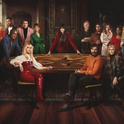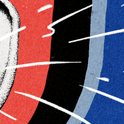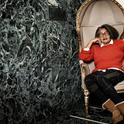When we look at a painting by Mondrian, we must push to the backs of our minds all the ways in which Mondrian’s own dream was subsequently corrupted, trivialised, or re-packaged as kitsch
You’re swimming in a placid sea. You stop to look around, treading water, letting your mind absorb the feeling of immersion. For a moment, the sky and shoreline disappear. You lose consciousness of your body. Instead, you’re hypnotised by the ever-shifting undulation of the water all around. Sunlight spreading in every direction brings news of each inversion, but at a rate the brain is too slow to register. Pooling pinpricks of light multiply into something infinite, something universal. Reality has been involuntarily abstracted. Digitised.
Piet Mondrian, I like to imagine, experienced something like this before he painted breakthrough works like Ocean 5 from 1914, and Composition No. 10 in Black and White, otherwise known as Pier and Ocean, from 1915. His response was to distil what he saw into a series of horizontal and vertical dashes, rhythmically arranged, and with just enough variation in length and spacing to capture the essence of it.
Mondrian was, you could say, the first digital artist. He was writing code before it was even invented. Computer code is the symbolic arrangement of data using ones and zeros, and Mondrian’s breakthrough paintings do something similar—capturing the world in a binary code of horizontal and vertical dashes. His inspiration was nature. But he was quick to see that the problem of representation was not a question of culture against nature, individual versus society, or the particular against the general. It was about everything. All at once. In dynamic equilibrium.
Mondrian, who is the subject of a show at Tate Liverpool timed to coincide with the 70th anniversary of his death, was the son of a school teacher. Born in 1872, he was raised in a strictly Protestant household by parents who nurtured his interest in art. He was visiting family in his native Holland when war broke out in 1914. He was forced to stay there for the next five years—a circumstance that made all the difference to the development of one of the most influential careers in modern art.
He had moved to Paris two years earlier—he was already 40—hoping to master the fundamentals of Cubism, the revolutionary method of picture-making invented by Pablo Picasso and Georges Braque. Living in the French capital at a time of unprecedented artistic tumult, he was inspired as much by the humdrum, rectilinear brick façades of buildings in Montparnasse as by the Parisian avant-garde.
Now, in Holland, as his colleagues in Paris pushed on in new directions—collage, lettering, trompe l’oeil, pattern-making, found objects, assembled sculpture—Mondrian remained obsessed with the earlier, purer stage of Cubist invention. That stage, known as Analytic Cubism, had taken Picasso and Braque to the brink of abstraction. And where they had balked, Mondrian now waded in.
He was a spiritualist, a truth-seeker. Heir to the Dutch tradition of unyielding Puritanism, he also shared with his 17th-century compatriot Spinoza the conviction that a link existed between geometry and ethics. His apprenticeship in Paris was crucial; but in the end, he had little in common with the cosmopolitan, poetic, partisan preoccupations of his French avant-garde colleagues.
A figure of almost monastic self-possession and open-hearted humility, Mondrian had a nose for the universal. He was attracted to theosophy, the esoteric philosophy, which melded east and west and sought to understand the phenomena, both hidden and revealed, that united humanity, nature, and the divine. In Holland he became closely involved with the De Stijl movement, and especially that group’s leader, Theo van Doesburg.
No. VI / Composition No. 11 (1920): Mondrian’s quest was to rid his work of what he called the “particularity” of the image. Tate. © 2014 Mondrian/Holtzman Trust c/o HCR International USA
Unlike earlier Mondrian exhibitions, the Tate Liverpool show emphasises his explorations of three-dimensional space. Mondrian’s thinking on this subject had much in common with ideas that were already coming to the fore in the fields of architecture and design. As far back as the 1890s, the Belgian painter and architect Henry van de Velde had described the architecture of his time as “a lie; all posturing and no truth.” Van de Velde and his contemporaries were reacting against the rampant eclecticism of the 19th century, and the obsession with ornament over functionality. Their attack on these old aesthetics carried an ethical implication. And this almost accusatory attitude towards the past only grew stronger as the old architecture, and the society it served, began to tear at the seams.
Across the Atlantic in America, the Dutch Pennsylvania and Shaker traditions of sobriety and simplicity stood ready to be revived in a strange new compact with modernity. Frank Lloyd Wright was at the forefront of a renovated aesthetic that transposed the hubris of verticality—a fight with gravity—into the harmonics of horizontality. Cleaving to truth ahead of beauty, the new architecture declared its function—above all, shelter—and its constituent materials openly. Nothing was to be hidden. Nothing superfluous. The seeds of the modernist notion that “less is more” had begun to sprout. So too had the ethical ideal of transparency. Ornament had no place in the new scheme. It was a lie, a crime.
The first De Stijl manifesto, composed in 1918 (but not published until 1922), made the state of things clear:
There is an old and a new consciousness of time.
The old is connected with the individual.
The new is connected with the universal.
The struggle of the individual against the universal is revealing itself in the world war as well as in the art of the present day.
Principally the work of van Doesburg, the manifesto went on to state that the new art would contain a balance between the individual and the universal. It would “realise the internal life as well as the external life.”
What did this mean? For Mondrian, it meant ridding his work of what he called the “particularity” of the image. (You can feel the spectre of Protestant iconoclasm in his thinking.) He systematically eliminated spatial illusion from his work, purging it of all hierarchy (no one aspect of the composition was to be more important than another), and all centrality (the edges of his pictures were given equal weight with the centre). All this in the name of greater “truth.”
Truth could be represented, believed Mondrian, by distilling the world into a system of verticals and horizontals. Straight lines were better than curved ones, since, historically, the curving line had been so closely associated with the by now thoroughly corrupted idea of beauty. (In any case, he saw straight lines as simply “tensed” curves.)
But lines alone were insufficient. Since Pier and Ocean, with its black lines superimposed on a white background, still implied a kind of depth or recession in space, Mondrian gradually introduced flat planes in primary colours (red, yellow, blue: more essentialism) connected together by thick black lines and dispersed across the (resolutely flat) pictorial field in dynamic, asymmetrical compositions.













